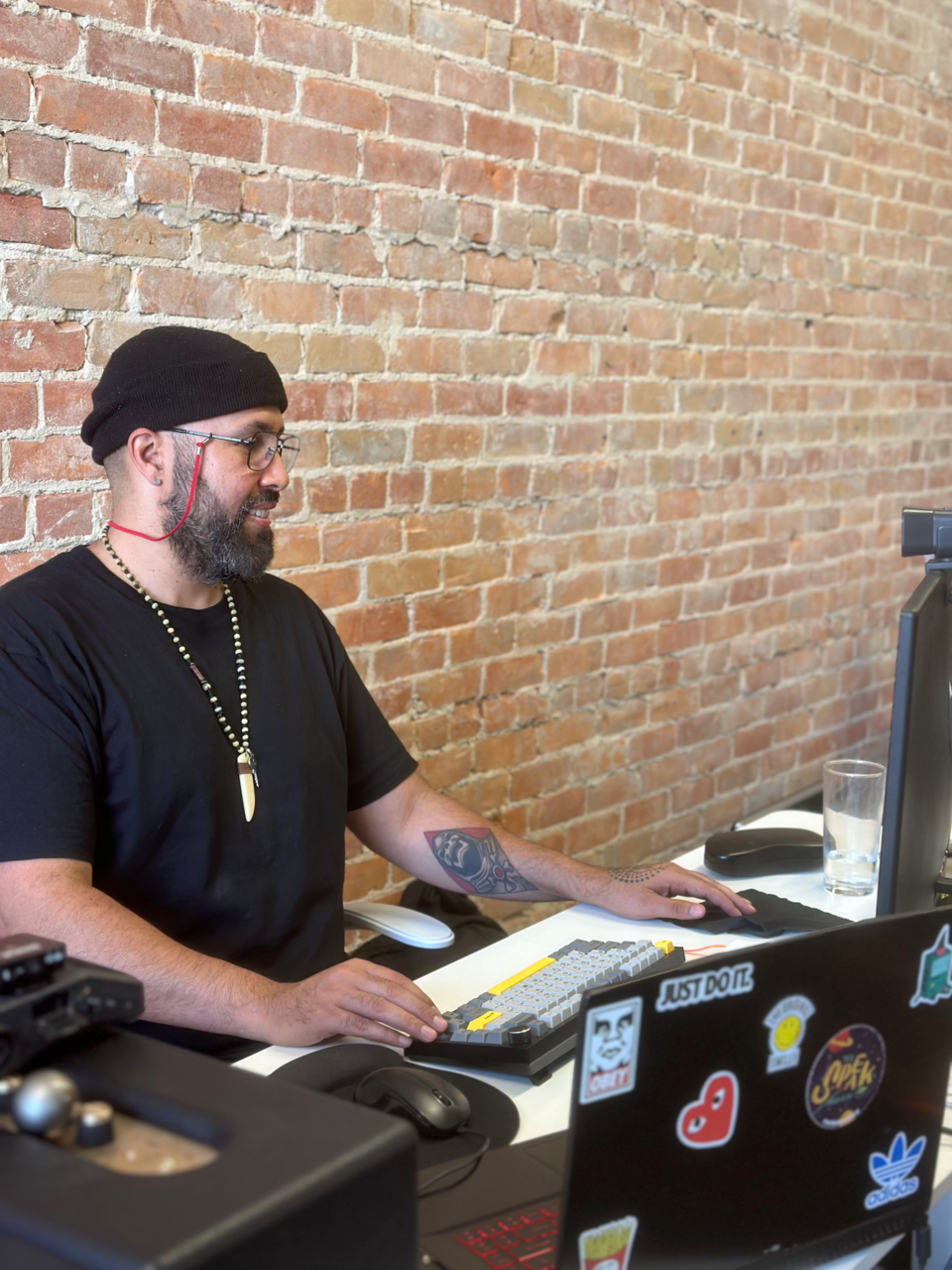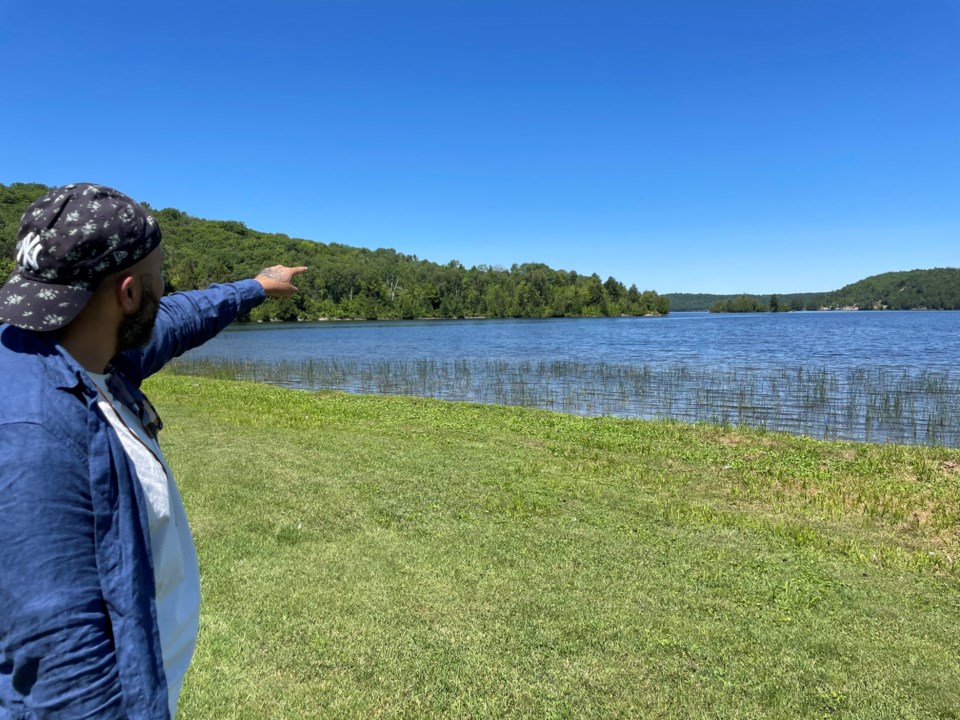In Ojibwe tales, the appearance of bineshiinh– the raven – can symbolize trust, honesty, and straightforwardness.
He often appears just as the main character is about to set foot on a path towards the unknown, or seeks guidance before undertaking a great quest.
Sudbury entrepreneur Clifton Skelliter considers it a good sign, then, when a curious bineshiinh circles overhead during an interview with Village Media on the shores of Whitefish Lake on Atikameksheng Anishnawbek.
“In this world, it's hard to know if people are telling you the truth,” Skelliter said. “And sometimes it's hard to know if you're being truthful with yourself. But, you know the line - ‘the truth will set you free.’”
“And I feel that there is no bigger purpose in life than to be and to feel free.”
Those traits - honesty, truth, and integrity - are some of the qualities Skelliter hopes to bring to the table as he launches his newest tech startup, The Indigenous Kore.
His background serves him well: He cut his teeth in the media and entertainment fields – news reporter, director, film producer and even co-star of a short-lived TV series called The Episode.
In the north, he’s probably best known as a storyteller: Skelliter’s film work has tackled some of popular culture’s most interesting characters. The documentary Bisping, about UFC fighter Michael Bisping, won several AMPIA awards and brought home several more LEO nominations in 2021.
His work has even made its way into the International film festival, Cinefest. Skelliter got the opportunity to contribute as a producer on All The Lost Ones, a movie about a woman fighting for her future during a civil war.
His branding firm, Launchpad Creative, sculpted the identity of Sudbury’s professional basketball team, the Five, and spearheaded the marketing behind one of the OHL’s most recognizable franchises, the Sudbury Wolves.
His creative work caught the attention of a team producing an exhibit about Princess Diana and her Royal photographer, Anwar Hussein. He was brought in as the artistic director and helped create a first of its kind walk-through documentary exhibit about the late royal icon.
In the early 2020s Skelliter again expanded his repertoire, and immersed himself in the world of Indigenous visual art. His curiosity – not to mention his contagious enthusiasm for new projects – led to him eventually being hand-picked by the federal government to curate the Indigenous art integration at 25 St Clair Ave East, their first carbon-neutral building.
A versatile portfolio, but all in all, Skelliter says he moves quite comfortably between worlds.
But, as Skelliter says, there’s a guiding philosophy behind every new venture, every new project he embarks upon.
“I think it's really key for Indigenous people, myself, my company, other organizations, other Indigenous people, we need to be using our ways of being when it comes to building technologies,” Skelliter said.
“We have to make sure our ways are connected and present in the things that everyday people use.”
At its base, The Indigenous Kore (TIK) is software designed to allow workforces to do a few fundamentally important things connected to safety, crowd sourcing knowledge from robust teams, and inclusion.
For one, the cloud-based SaaS platform simplifies safety and certification management for employees and vendor staff. That includes modules to keep track of employees’ safety certifications, timesheets (that includes a function to upload photos), incident reports, customizable forms, as well as incident reports, as well as tracking vendors associated with the organization.
“Everybody out there is trying, everybody out there wants more Indigenous people on their teams,” Skelliter says.
“The beauty of this particular platform, though, is that it does something that no other software does. It actually compels organizations to increase Indigenous participation in their workplace.”
That will be a big boost for operations looking to maximize their impact in Indigenous communities. It will also benefit those First Nations who continually look for opportunities to employ the largest number of band members in large projects.
“You're asking yourself, why is that important?” Skelliter said. “It’s all about accountability.”
“When you work out at home, you get a so-so workout. When you work out at the gym, with people around potentially watching, you go hard..”
Skelliter also touts the potential for inclusion – more Indigenous involvement in day-to-day decisions on the economic side when it comes to business partnerships with groups outside the community.
That’s something Skelliter says he missed growing up.
“I watched people in my family miss out on opportunities because they didn't look and sound a certain way," he says.
"I didn't look a certain way so I had a hard time imagining myself becoming successful."
“When working in the media I got put into a box, and people didn’t have the vision to see me outside of that box, no matter how much I pushed. I was just not able to break through and I had to go off on my own and start creating things.”
Now, he says, he’s in a position to offer a product and service that not only helps people in similar situations access meaningful work, but also encourages companies to put inclusion and responsibility at the forefront.
“And when private companies work on these territories, they can now enter into mutually beneficial agreements where hiring people from their Nation is part of the agreement,” he says.
It’s the way forward, Skelliter says, as both community and company can be open and transparent with one another, a good and necessary foundation for any business arrangement.
Another element that sets TIK apart is that it was built not only from a user perspective – the interface is simple, easy to use – but it also incorporates Indigenous ways of being into its design.
“This version is about inclusion but later versions will have language models built into it to help preserve the languages by ensuring they are being used." Skelliter says.
"This is what we mean when we talk about the power of Indigenous Digital Equity".
“As Indigenous people around the world, we also need to be creating digital tools, and our voice needs to be imprinted on these different tools.”

What’s at stake?
That type of inclusion will come as a huge boost for communities looking for input into economic decisions that affect their territories and their members.
Craig Nootchai, recently re-elected Chief of Atikameksheng Anishnawbek, says software like TIK could have an immediate impact in First Nation communities.
“We're right in the heart of mining country, so we need to be able to operate at the speed of business,” Nootchai says. “That means we really need to take stock of all of our human resources that we have in our community.”
“And it has to be instantaneous, it has to be dynamic, it has to be easily transferable between programs.”
The potential, Nootchai says, of making operations seamless between companies that operate on First Nations, as well as the communities themselves, is enormous.
“What's at stake here is getting a seat at the table,” Nootchai says. “And then once we're there, providing input and feedback into what goes on in our territory. Really changing the landscape to fit our narrative.”
Without that involvement, Nootchai says, an entire generation could be at risk of missing out on moving ahead.
“We are going to lose out on the next generation who could be game-changers in this industry,” Nootchai says. “In our First Nation, we're looking at different types of businesses – it could be mining, it could be the film industry – but there's an IT aspect to all of them.”
“So we need to understand that piece, too.”
Building the set of skills needed to operate in an IT environment is essential for any community, Nootchai says, especially when considering the impacts on youth of having long-term employment available.
“We can't always rely on third-party consultants to do that for us, we need to build in-house,” Nootchai says. “That's what we're hoping for. That the next generation wants to take part in this and they'll understand that this industry is really consultant-driven.”
But it all comes down to knowing your way around the business table, too, Nootchai says, and developing a sense of “business-savvy.”
“We want to offer stability, right? We want to say, ‘Hey, if you do this, there's stability in the community, and you'll be able to get a long-term career job.”
And entrepreneurs like Skelliter are positioning themselves at the forefront of the relationships between those communities and the business world.
“What I hope from The Indigenous Kore is that this tool ends up becoming a connector,” Skelliter says. “That this database of skills and workers can be accessed by people who, in good faith, want to work with Indigenous people.”
“And that those companies can access this database and find a workforce that is ready, willing, and able to go out there and do incredible work. And that we can connect them with some of the hardest-working people you'll ever meet, some of the best people for the culture of their organization.”
“I guarantee that when people connect, we will all benefit from it,” Skelliter says. “We will have a better economy, and we will have a better workforce culture.”
